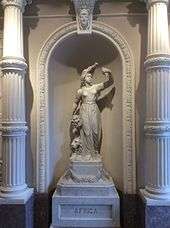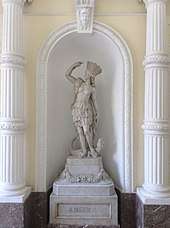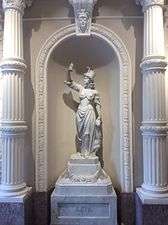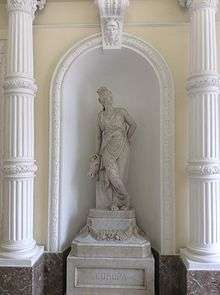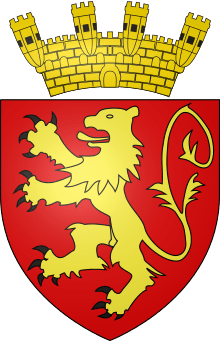Palazzo Ferreria
Palazzo Ferreria, officially Palazzo Buttiġieġ-Francia,[4] is a palace found near the entrance of Valletta, the capital city of Malta. It was built in the late 19th century.[5] Designed by Architect Giuseppe Bonavia, makes use of an interesting concept of adding local timber balconies to a design inspired from that of buildings in Italy. It is protected as a Grade 2 national monument.
| Palazzo Ferreria | |
|---|---|
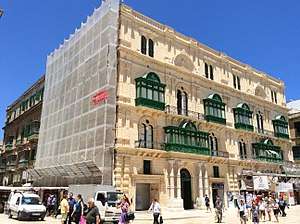 Palazzo Ferreria during restoration in 2017[1] | |
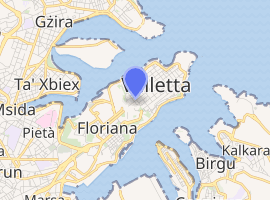
| |
| Former names | Palazzo Francia |
| General information | |
| Status | Intact |
| Type | Palace |
| Architectural style | Venetian Gothic[2] |
| Location | Valletta, Malta |
| Coordinates | 35°53′48.6″N 14°30′36″E |
| Named for | John Louis Francia |
| Completed | 1876 |
| Owner | Government of Malta |
| Technical details | |
| Material | Limestone |
| Design and construction | |
| Architect | Giuseppe Bonavia[3] |
History
On the plot of the palace a former foundry of the Order of St John existed to manufacture the knight's armaments. Giuseppe Buttigieg and his wife Giovanna Camilleri acquired the land from the government, and they built Palazzo Ferreria in the late 19th century. Visibly on the façade are the coat of arms of Buttiegieg and Camilleri. The palace was left as dowry to their daughter Teresa Buttigieg. She married Colonel John Louis Francia for whom the Palace got its name for a while. Francia was a Spanish citizen from the British colony Gibraltar, and the two met in Malta while Francia was on duty with the British army. Palazzo Ferreria is the second biggest palace in Valletta after the Grandmaster's Palace.[5]

The Francia family resided at the palace until the end of World War Two, in 1947. The war had destroyed or partly damaged most buildings in Valletta. The Labour government, led by Dom Mintoff, rented part of the palace from the Francia for the Public Works Department, to reconstruct and restore Valletta from the war damage. The family kept a small part of the palace as an apartment which is now used as a Maltese government Ministry's office.[6] The Francia sold the palace in 1979 to the government which was administered once again under Prime Minister of Malta Dom Mintoff. Today the lower parts of the palace consist of several shops.[5]

Architecture
The architect of Palazzo Ferreria is Giuseppe Bonavia, who also designed the Lija Belvedere Tower and La Borsa.[7] The palace is scheduled as a grade 2 national monument by the Malta Environment and Planning Authority (MEPA).[8] Bonavia wanted to develop this site after losing the bid to become the architect of the Royal Opera House (opposite) and to show what he was capable of building and what could have resulted had his design been chosen over that of Edward Middleton Barry.
Gallery
Further reading
- Spiteri, Stephen C. (2003). Armoury of the Knights. Midsea Books. p. 65. ISBN 99932-39-33-X.
- Ownership of Palazzo Ferreria
- The Palazzo Ferreria (Francia) saga
- Sette Giugno attack, family and coat of arms
- Scicluna, Frank L. (January 2014). Sette Giugno. ozmalta.com. Consulate of Malta in South Australia Newsletter. p. 8. Retrieved on 12 October 2016.
- New clothing store opens in historic city palazzo
- Jinbeda r-restawr fuq Palazz Ferreria
References
- Scicluna, Edward (17 October 2016). "Health, Sports and Culture". Budget Speech 2017 (PDF). Valletta: Ministry for Finance. pp. 139, 140. ISBN 978-99957-58-15-8.
- Bugeja, Lino (4 January 2015). "Valletta – vibrant city of many styles". Times of Malta. Retrieved 10 March 2016.
- Bugeja, Lino; Buhagiar, Mario; Fiorini, Stanley (1993). "Artistic, architectural and ecclesiastical aspects". ISBN 9990944024, 9789990944020. p. 454.
- Gauci, Joseph (19 January 2009). "Brief history of Palazzo Ferreria". Times of Malta. Retrieved 10 November 2015.
- Gauci, Joseph (19 January 2009). "Brief history of Palazzo Ferreria". Times of Malta. Archived from the original on 15 April 2012.
- "Ministry of Education, Employment and the Family". malta.com. Archived from the original on 15 September 2014.
- Sant Fournier, Steve. "Villa Gourgion and the Lija Belvedere". user.orbit.net.mt. Archived from the original on 5 February 2015.
- http://www.timesofmalta.com/articles/view/20090106/opinion/one-world-protecting-the-most-significant-buildings-monuments-and.239713
External links

